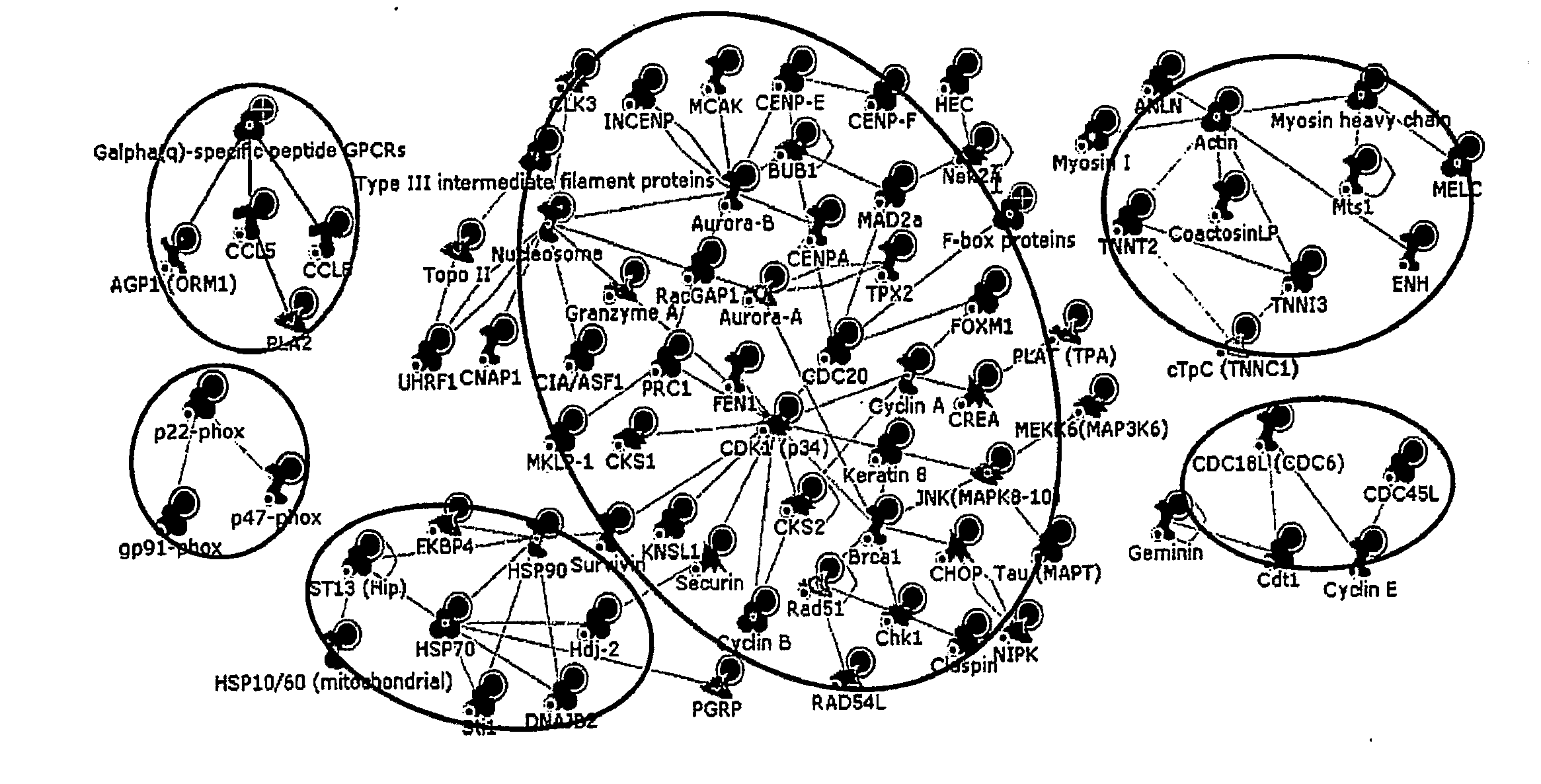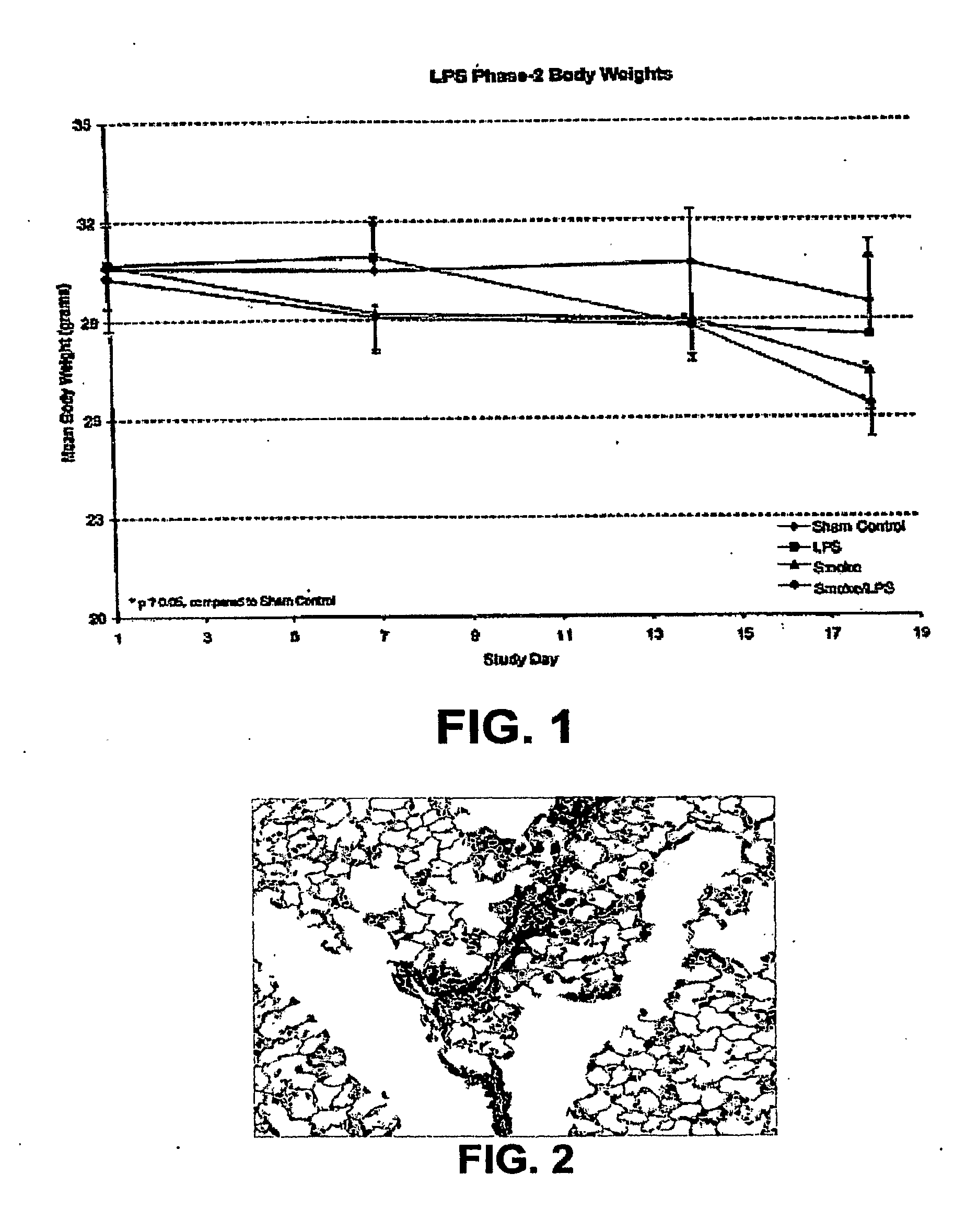Animal Model for Assessing Copd-Related Diseases
a copd-related disease and animal model technology, applied in the field of animal model for assessing copd-related diseases, can solve the problems of limiting the usefulness of the animal model for mechanistic research and therapeutic development, requiring unduly long-term intensive smoke exposure, and failing to provide clear evidence of definitive pathological changes in the affected tissue. severity and/or delay
- Summary
- Abstract
- Description
- Claims
- Application Information
AI Technical Summary
Benefits of technology
Problems solved by technology
Method used
Image
Examples
example i
Maker Capability—Characterization of Inflammatory Responses in Mice Upon LPS and / or Cigarette Smoke Exposure
[0210]Test System—Test Animals were male AKR / J mice. The test system information is summarized in TABLE 1 below.
TABLE 1SpeciesMus musculusStrainAKR / J; referred as NJ in this reportSourceJackson Lab, Bar Harbor, MENumber for Study90 miceTotal Number and Date250 males received Feb. 01, 2005Age−9-13 weeks at exposure startIdentificationTail tattoo (AIMS, Inc.; Piscataway, NJ);Placement within the chamber cage unitExposure Day 1Feb. 03, 2005Terminal Sacrifice / NecropsyMar. 18, 2005
[0211]Acclimatization to Restrain Tubes
[0212]Prior to exposure, the animals were placed in the nose-only restraint tubes for acclimatization. The nose-only exposure tubes have a number of features to minimize stress, such as body ventilation holes and channels to remove urine and feces.
[0213]Group Assignment
[0214]The Xybion PATH / TOX SYSTEM™ (Xybion Medical Systems; Cedar Knolls, N.J.) was used for randomi...
example ii
Gene Expression Profiling in Lung Tissues from Mice Exposed to Smoke, LPS, and Smoke+LPS by Inhalation
[0297]Animals and Exposure
[0298]AKR / J male mice were purchased from Jackson Laboratory (Bar Harbor, Me.). Groups of 6 mice were exposed via nose-only inhalation to one of the following: i) HEPA-filtered air (sham control group); ii) mainstream cigarette smoke at 250 μg / L wet total particular matter (WTPM) for 6 hrs / day, 5 days / week (smoke group); iii) 0.5 μg LPS / mouse for 1 hr / day, twice per week (LPS group); or iv) cigarette smoke at 250 gg / L WTPM, 5 hrs / day, 5 days / week, plus 0.5 gg LPS / mouse for 1 hr / day, twice per week after smoke exposure (Smoke+LPS group) for 3 consecutive weeks.
[0299]When not exposed to LPS, mice were exposed to HEPA-filtered air, so the exposure periods for each group were always 6 hrs per day. Cigarettes were 2R4F reference cigarettes procured from University of Kentucky (Lexington, Ky.). LPS from Escherichia coli serotype 055:B5 phenol extract was purchase...
example iii
Marker Capability Development Related to an Animal Model for Chronic Obstructive Pulmonary Disease (COPD) Investigation Using LPS and Cigarette Smoke Exposure
[0376]Characterization of Lung Proteome IN Mice Upon LPS and / or Cigarette Smoke Exposure
[0377]This example combines mass spectrometry (MS) proteomic methodology with mixed effects linear statistical modeling to identify proteins whose concentrations change due to treatment effects. Lungs from mice exposed vis 3-week inhalation to LPS, cigarette smoke (Smoke) and Smoke+LPS or sham controls were digested with trypsin and evaluated by tandem mass spectrometry and FTICR (Fournier Transformed Ion Cyclotron Resonance)-MS approaches as described previously. SEQUEST® analysis of the MS data identified 3219 peptides corresponding to 2834 proteins on the NCBI database. Protein Prophet® reduced the number of identified proteins to 1240 by grouping isoforms and other database entries with highly similar amino acid sequences.
[0378]The varia...
PUM
| Property | Measurement | Unit |
|---|---|---|
| time | aaaaa | aaaaa |
| time | aaaaa | aaaaa |
| time | aaaaa | aaaaa |
Abstract
Description
Claims
Application Information
 Login to View More
Login to View More - R&D
- Intellectual Property
- Life Sciences
- Materials
- Tech Scout
- Unparalleled Data Quality
- Higher Quality Content
- 60% Fewer Hallucinations
Browse by: Latest US Patents, China's latest patents, Technical Efficacy Thesaurus, Application Domain, Technology Topic, Popular Technical Reports.
© 2025 PatSnap. All rights reserved.Legal|Privacy policy|Modern Slavery Act Transparency Statement|Sitemap|About US| Contact US: help@patsnap.com



